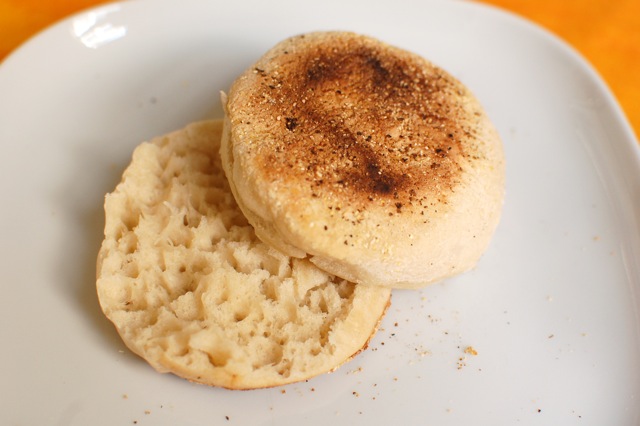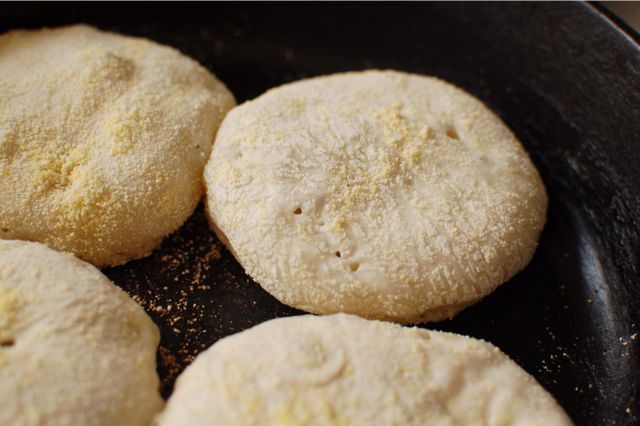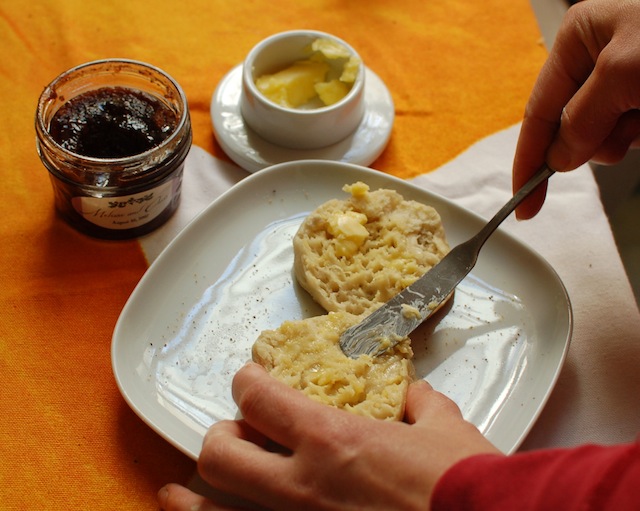They were pretty damn good, I must say. Toasting one right now….
Here’s a recipe, or as close as possible since I was free-styling it that morning.
SOURDOUGH SPONGE
The night before, take out of the fridge your sourdough starter (see my feature “Taming the Wild Yeast“). Transfer to a clean bowl and mix in the hootch (dark liquid on top) if you like more assertive sourdough flavors; pour off the hootch if you don’t. You’ll need about 1 cup of starter. Stir in about 2 cups of unbleached AP flour and 1 cup tepid, filtered water. Covered with a cloth and let ferment overnight.
SOFT DOUGH
The next morning, about an hour before serving, remove about 3/4 cup of the sourdough sponge, feed it a little more flour and water, and then return it to the fridge. Over the sponge left in the bowl, sprinkle evenly about 1 1/2 cups of flour, 1~2 tablespoons sugar, 1 teaspoon salt, and 3/4 teaspoon baking soda. Stir to bring together the dough, then turn it out onto a floured board. Knead gently, working in just enough additional flour to keep the dough from from sticking too much. The softer the dough, the better, so work quickly and keep your hands floured. I prefer to leave just a bit of stickiness; it makes for less perfect-looking muffins, but they’re super tender. You shouldn’t knead the dough more than 2 or 3 minutes.
CUTTING & RESTING
Pat the dough to 3/4-inch thick and cut with a sharp, floured biscuit cutter. (A dull cutter or a glass rim will seal the edges and prevent good height.) Sprinkle a sheet pan with cornmeal. Transfer the muffin rounds to the sheet pan with an off-set spatula, making sure to leave space between them, and then sprinkle the tops of the muffins evenly with cornmeal. Cover with a cloth and let rise 45-60 minutes.
COOKING
Heat a cast-iron skillet or griddle over high until very hot. Brush lightly with oil, and then transfer the muffins carefully to the pan. Immediately reduce the heat to medium. Cook until golden brown, 3 to 4 minutes on each side, rotating as needed for even cooking. The high initial heat will provide the spring needed to form all those lovely nooks and crannies before the gluten sets. Cooking entirely over medium or low heat will give you thin, flat muffins, which some people (like my dad) love. I prefer the thicker, softer ones.
To cool, transfer to a rack for a crisp exterior. Brush out any scorched cornmeal, coat pan again with oil, and return to high heat. Repeat with remaining muffin rounds.
They freeze well. You can cut them in half before you freeze them for easier toasting, but they’ll dry out more readily in the freezer. If you want, you can poke a wooden skewer laterally around the equator for splitting with a fork later.
Enjoy.
P.S. To make inexpensive molds, you can eat 4 cans’ worth of tuna, remove both the top and bottom of each can, wash well, and then use them for holding thin doughs. They also make perfect molds for the eggs that go into the muffin sandwiches. Yum.
Related: Taming the Wild Yeast



They look great. I look forward to trying this. Why did you add baking powder? Also, what does one do with English muffin tins? You don’t use them in the recipe, AFAICT. You might want submit this to “yeast spotting” on http://www.wildyeast.com